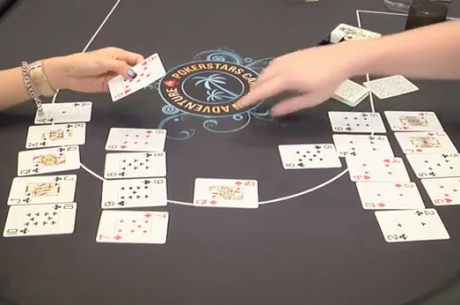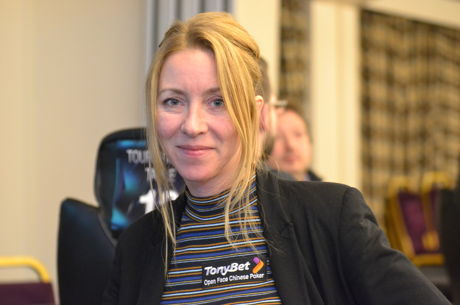Open-Face Chinese Poker by Isabelle ��No Mercy�� Mercier, Part 4: Knowing Is the Key
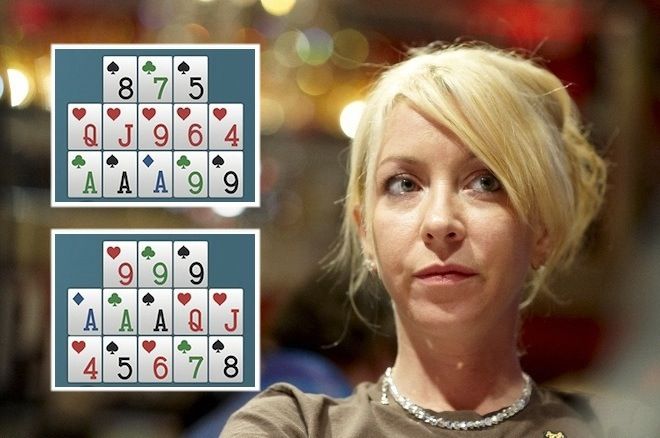
Tonybet Poker ambassador Isabelle Mercier returns with more tips and advice for playing open-face Chinese poker, this week demonstrating the importance of knowing points and royalties when setting your hands.
Hello all, and welcome back to my ��Open-Face Chinese No Mercy Little Guide��! Now that we have gone over the history of the game and its basic rules, today we will start to explore the ��Pineapple�� variation of OFC with Fantasyland in more detail.
Remember that placing a pair of queens or better on the top line (without fouling, of course) gets you to Fantasyland initially. However, once you are in Fantasyland, the only way to stay there will be to make trips on top or at least four of a kind in the middle or in the back. Otherwise, you can imagine how easy it would be to stay in Fantasyland if the queens on top remained sufficient!
Let me guide you through some primary recommendations to help elevate your ��Pineapple�� game if you are a new player.
Advice #1: Knowing Points and Royalties
On my OFC app, I have a few ongoing games with friends who don��t even know how many points they earn by making a full house on the bottom line! (No wonder I am ahead 800 points against them �� LOL!) They know who they are, especially those who keep insulting me because of my supposed ��luck��!
Before you start playing OFC at all seriously, you have to take some time to look at the points and royalties and get to know them by heart. It might seem obvious to know the rules of the game, but I assure you that there are a lot of recreational players out there who play intuitively, not knowing how many points they will get in the end and just letting the computer do the math for them.
This is kind of silly and lazy, because we should be setting our cards in different ways according to the points and royalties we can make. It��s even more important to be aware of points and royalties when in Fantasyland, where you have the best chance of getting more of them.
When in Fantasyland, we will often have many possibilities and choices to make when setting our hands. What options can make us scoop? Which placement will give us royalties? What will make us win more money? In order to find the best answers to these questions and make the best possible decisions, you have to know the points and royalties.
Take a look at the following example:
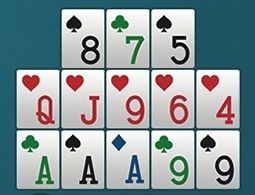
Having been dealt these cards, most of the time inexperienced players will quickly put their full house in the back and their flush in the middle, leaving the crappy cards to make a very weak line on top.
In this particular case, the full house bonus is worth 6 points, and the flush in the middle is 8 points, for a total of 14 points in bonuses. That��s not bad, but you are very unlikely to scoop your opponent with this board because of the 8-high on top.
Say you had the same 13 cards, but instead placed them in this manner:
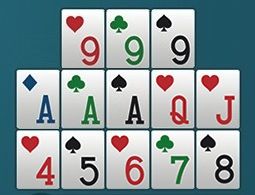
Here the straight bonus on the bottom is only worth 2 points and trips in the middle also only good for 2 points. But the bonus for trip nines on the top is a whopping 17 points! That��s a huge difference compared to what we had before �� we��re getting 21 points�� worth of bonuses versus only 14. On top of that, with a hand that strong on every line, there is a real chance to scoop your opponents and win another 6 points on top of your 21!
The goal is not always to make the strongest possible hand, but it certainly is always to make as many points as possible. You can make more money simply by knowing the points and royalties and placing your cards differently with them in mind.
If you don��t want to learn and memorize the bonus chart, at least remember this �� when you can find a way to place trips on top, that��s probably the right play. And it will take you back to Fantasyland!
Advice #2: Setting Your Initial Cards
Let��s turn to talk a little about setting your first five cards in Pineapple OFC. As you will not be able to move your cards once they are placed, your initial positioning is the absolute foundation of your hand. It reminds me of classic chess openings, which set the stage for everything that follows.
Sometimes it��s obvious how to set your first five cards, and other times there will be a few different possibilities. Whenever I receive an Ax or a Kx, for instance, I��m very much inclined to put this card in the middle, as it is my ��joker�� card that makes it easier to make a pair of queens on top. That being said, if either my ace or king is a diamond to go along with four other diamonds, there is a very good chance I will place my flush in the back, especially if I am last to act and see many more diamonds already out there in my opponents�� hands.
However, if I receive a pair of kings or aces to start the hand, it is unlikely I will place it on top right away. And when I get two pair to start, I will very rarely separate them. Don��t forget, not giving up points is a big part of this game!
Here are three examples of starting hands that will give you an idea of how I like to set my first five cards:
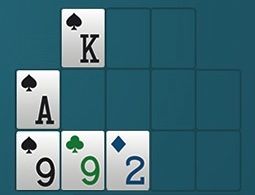
In this first example, you��ll have to choose whether to put a three-card flush in the back, or separate those three spades in a different manner. I��m a big fan of this positioning, as it makes it quite easy to make two pair in the back, aces in the middle, and kings on top. For sure an ace-high flush in the back is a good hand, but it��s not leaving me with much else, is it? I��ll have that ugly 9?2? in the middle, not to mention a nine is already dead in my back line. Doesn��t seem like a lot of potential to me.
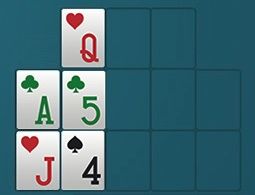
In this one, I��m still looking at my ace in the middle and my queen on top, always with the objective of making at least two pair in the back, then aces in the middle with queens on top.
Here I like to put the 5? in the middle, leaving the door open for a flush in the middle in case I successfully make a full house in the back. What justifies my decision is that the five as much as the four are both connecting cards to a straight in the middle with the ace. So no matter which one I choose to place there, it will have the same influence on my chances of making this straight eventually.
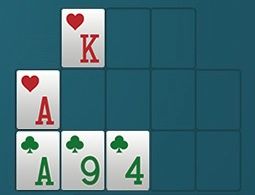
Now these five cards offer many different possibilities. Of course, all of these possibilities are theoretical, and observing the cards already showing on your opponents�� boards is crucial for deciding how exactly you��re going to place your five cards. But for practical reasons let��s just assume we are first to act. How do we set these five?
In this particular case, I like to split my aces (which will be extremely rare), because the flush seems relatively easy to make, and I��ll still be aiming for aces in the middle and kings on top. Should I put my king in the middle along with my ace, knowing one ace is already dead in my own hand? I could catch a king in the middle and still make queens on top. I don��t know�� what do you think about this?
We��ll stop there for now. Enjoy the weekend, and we��ll rendez-vous next week for the next part of my ��OFC No Mercy Little Guide.��
Meanwhile you can try the game today by downloading Tonybet Poker and using the bonus code NOMERCY to receive 100% bonus up to �500 and a free ticket for a weekly Pineapple NoMercy Ride tournament!
Want to stay atop all the latest in the poker world? If so, make sure to get PokerNews updates on your social media outlets. Follow us on Twitter and find us on both Facebook and Google+!
In this Series
- 1 Open-Face Chinese Poker by Isabelle ��No Mercy�� Mercier, Part 1: OFC Poker Basics
- 2 Open-Face Chinese Poker by Isabelle ��No Mercy�� Mercier, Part 2: Counting Points and Royalties
- 3 Open-Face Chinese Poker by Isabelle ��No Mercy�� Mercier, Part 3: The 3 Pineapples
- 4 Open-Face Chinese Poker by Isabelle ��No Mercy�� Mercier, Part 4: Knowing Is the Key
- 5 Open-Face Chinese Poker by Isabelle ��No Mercy�� Mercier, Part 5: Being Observant in OFC
- 6 Open-Face Chinese Poker by Isabelle ��No Mercy�� Mercier, Part 6: The Two-Pair Pickle
- 7 Open-Face Chinese Poker by Isabelle ��No Mercy�� Mercier, Part 7: Going for Fantasyland
- 8 Open-Face Chinese Poker by Isabelle ��No Mercy�� Mercier, Part 8: Playing Safe Against a Risk-Loving Opponent
- 9 Open-Face Chinese Poker by Isabelle ��No Mercy�� Mercier, Part 9: Focusing on Fantasyland



